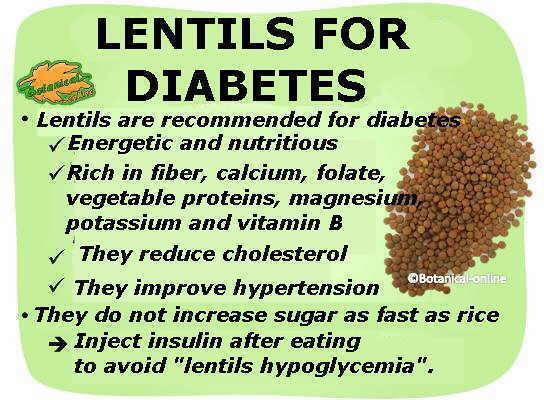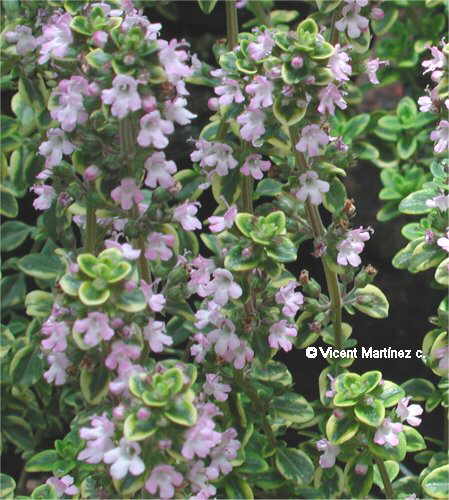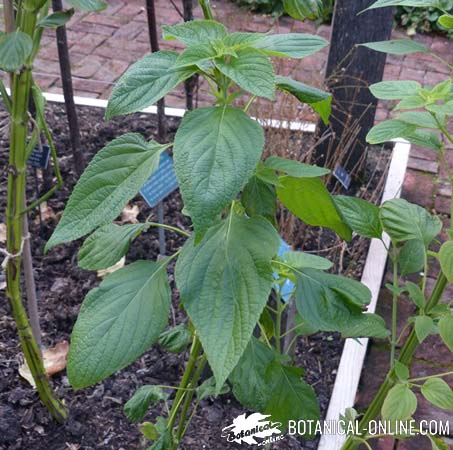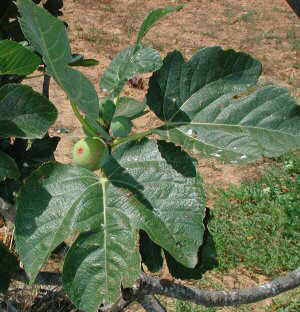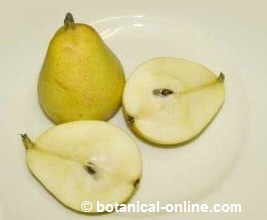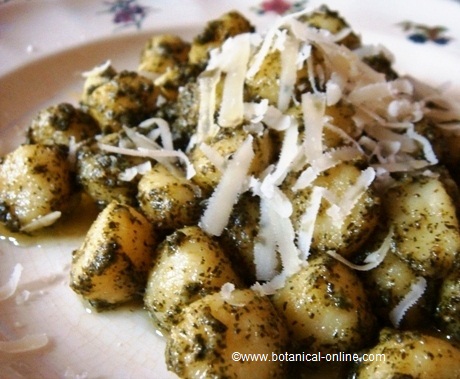Contents
Types of Omega fats and foods containing them
Essential fatty acid sources
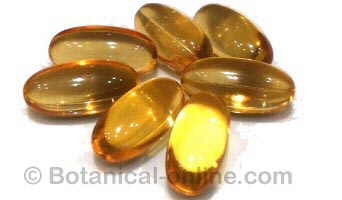
Evening primrose oil is administered in pearls for better conservation and dosage
Do you need to take supplements with omega 3 and omega 6?
No, in normal health, a healthy and balanced diet is enough to provide enough omega 3 and omega 6.
Also, fortunately, there are foods that already provide fatty acids EPA and DHA assets, That is to say, they do not require more changes in the body or enzymes.
Therefore, directly eating EPA and DHA (oily fish) has an advantage, for example, for older people with reduced processing capacity of omega-3 EPA and DHA derivatives.
That is, older people should eat foods directly with EPA and DHA, such as oily fish, the best omega-3 “food-supplement”.
Foods rich in omega 3
Linolenic acid (omega 3) is transformed in the body into eicosapentaenoic acid (EPA), a necessary component for making antiinflammatory substances (called prostanoids).
In turn, EPA is transformed into docosahexaenoic acid (DHA), an abundant substance in the brain, essential during pregnancy for the formation of the fetal nervous system, and also important for good vision health
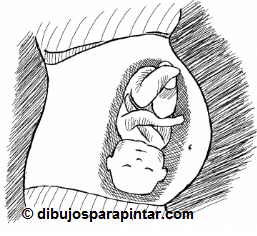
Essential fatty acids are very important in the diet of pregnant women. © ©Dibujosparapintar
- Foods rich in omega 3 (linolenic acid or ALA): Very few foods are rich in omega 3 fatty acids, as the foods tha contain them are especially rich in omega 6. For example, walnuts provide a lot of omega 3, but also a large amount of omega-6.
Overall, we could summarize it would be interesting to reduce vegetable oils and consume foods that especially provide omega-3, such as walnuts, flaxseed flour and chewed chia seeds.
It has been seen that the excessive consumption of omega 6, which is currently due to pastries, oils, fried foods, margarines, etc, produces such an imbalance, that reduces the benefits of omega 3.
- Linseed oil: It is sometimes given as a supplement of omega 3. It contains much linolenic acid (ALA). From this substance the body can synthesize EPA and DHA. Generally flaxseed oil is not recommended as a source of omega 3 because these fats, which are polyunsaturated and very sensitive to heat, are easily oxidized in the oil, so if it is not kept very well (refrigeration), it loses its properties and may even be oxidizing. Like other seed oils, it should not be used for cooking.
* Foods rich in EPA and DHA: They are two very different types of beneficial omega-3 for health. It is considered more potent omega 3 because they are active substances with blood fluidifying, vasodilating and anti-inflammatory properties.
EPA and DHA are essential nutrients for people with heart problems, heart failure, hypertension, obesity, arthritis and inflammatory processes.
From DHA neuroprotectin D1 and important substances for the nervous system are synthesized, so it is sometimes recommended for hyperactivity, mild depression, eyestrain, pregnancy, etc.
Both types of fatty acids, EPA and DHA, are easily interchangeable forms and, thus, the formation of one or other is regulated in the body depending on the needs. Generally they have an important role in improving circulation, nervous system, pregnancy, and reducing inflammatory processes in which these nutrients can intervene.
Omega 3 EPA and DHA are found mainly in:
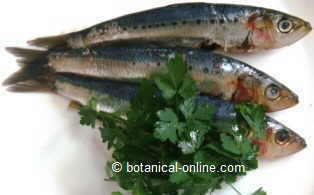
Sardines are richer in EPA and DHA that supplements of fish oils
- Blue Fish: Oily fish is the most abundant, better even than food supplements and the best source of omega 3 EPA and DHA, because they provide a very high amount of these fats. Fatty fish should be cooked at low temperature to prevent to damage its omega-3 (sushi, iron at mild temperatures, etc.). ‘Do not burn these foods on grills or pans !!
Small fish are recommended (sardines, mackerel,…) because they contain less heavy metals than the large (salmon, tuna,…) .
As EPA and DHA supplements we have:
- Fish Oil: Supplement made from fish oils. Trademarks that ensure cold extraction and low heavy metal content are recommended. Supplements do not contain as much omega 3 as the fish itself.
- Krill Oil NKO: It is the most potent supplement of DHA and EPA and has better digestion, because their fatty acids are not bound to triglycerides but directly to phospholipids. It is recommended to look for cold extraction.
* See: DHA supplements for vegetarians
Foods and supplements rich in omega 6
Linoleic acid (omega 6) has anti-inflammatory functions, such as omega 3, but if consumed in excess can trigger inflammatory processes. Too much omega 6 is usual in diets where many fried foods, pastries, etc are consumed.
- Foods rich in omega 6 (linoleic acid or LA): The vast majority of seeds and oils used in food are rich in linoleic acid such as sunflower oil, sesame oil, walnuts oils, etc. Although these oils and nuts may contain some amount of omega 3, omega 6 is always more abundant.
Seed oils should not be used for cooking because their omega fats, which are very sensitive to heat, deteriorate. These oils should only be used in its 1st cold pressure and they must be used for seasoning raw dishes.
No omega 6 supplements (linoleic acid) are given because any diet provides them in a large amount. The only supplement rich in omega-6 would be:
- Wheat germ oil: Actually recommended because it is the richest in vitamin E that exists, with antioxidant properties. It also contains essential omega 6 and a lesser amount of omega 3. One tablespoon of wheat germ oil provides 190% of the recommended daily allowance of vitamin E.
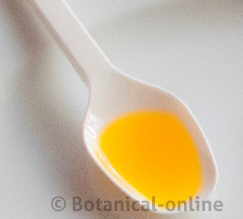
Wheat germ oil from 1st cold pressure is the richest in vitamin E. It has very distinctive orange color. One teaspoon provides all the necessary vitamin E a day
* Foods rich in GLA (gamma linolenic acid): It is the only type of omega 6 which requires supplementation because no foods provide it naturally.
Gamma linolenic acid (GLA) (not to be confused with linolenic acid, which is an omega 3) is considered the more potent omega 6 because it is the direct precursor of dihomo-γ-linolenic acid (DGLA) and this one is of prostanoids series 1, with vasodilatory and anti-inflammatory properties.
There are few foods rich in GLA, among which the most prominent supplements are:
- Borage oil: Refers to the oil extracted from borage seeds, not to the plant as such, used as food. Although borage oil is the richest in GLA (20%), there is some doubt about their consumption due to some toxicity by the presence of pyrrolizidine alkaloids, which may damage the liver. For this reason evening primrose oil is preferably used.
- Evening primrose oil: It is the most commonly GLA supplementation used, mainly in skin diseases, such as acne or psoriasis, to balance hormonal disorders, in premenstrual syndrome, polycystic ovaries and inflammatory diseases such as arthritis. It contains between 7 10% GLA and, unlike borage, it has no toxicity.
* SUMMARY * Which are the best foods with omega-6 and omega-3? The most potent omega-6 oils are supplements of evening primrose and borage (GLA). The most potent omega-3 are provided by the small oily fish, cooked gently. Broiling, burning or frying fatty fish destroys valuable omega 3, which are EPA and DHA acids. In omega-3 supplements, the best would be krill oil or fish oils, but they are not necessary when oily fish is consumed 3 times a week. In vegetarian diets, as intake of omega 3 you can daily eat 7 walnuts as a source of omega 3 or flax meal or chia seeds well chewed. To avoid inflammation and enhance the benefits of essential fatty acids, you should eat little animal fat, eliminate trans fat, not to exceed when using vegetable oils for cooking, avoid alcohol, tobacco, and chronic stress. * More information: Anti-inflammatory diet |

